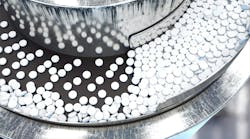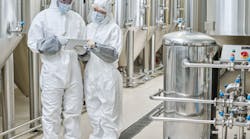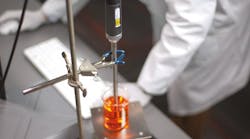There is often a strange contradiction between advances of the diagnosis and treatment of serious diseases and the understanding of their cause. For example, advances in breast cancer have led to significantly improved survival rates, while the causes are still not fully understood. However, there has been relatively little progress in developing and commercializing broad and effective therapies for genetic disorders, such as Duchenne Muscular Dystrophy (DMD), affecting around 1 in 3,600 boys. Yet the cause of DMD is well understood.
DMD is caused by a mutation in the dystrophin gene, the largest gene located on the human X chromosome, which codes for the protein dystrophin, an important structural component within muscle tissue that provides structural stability to the dystroglycan complex (DGC) of the cell membrane. The physical effects of DMD are progressive and severe. Starting with early age muscle weakness, patients are usually wheelchair bound by age 12 with progressive muscle deterioration and loss of movement leading to paralysis. Average life expectancy is around 25 years. Currently there is no cure for DMD.
Modern DNA testing provides improved confirmatory diagnostics, and the conditional European approval of PTC Bio’s DMD therapy Translarna™ in July fuels hopes for a break through therapy. The quality of life and life expectancy of many DMD patients is being improved by use of a combination of physical therapy and drugs such as corticosteroids and beta2-agonists. However, the impact of the disease on the patient and their families is simply devastating.
The dream of an effective gene therapy is to treat diseases by transfer of “good” genetic material into a patient to complement or to create a sustained correction in aberrant gene expression, such as with dystrophin in DMD. The gene therapy concept, developed in the 1950s was inspired by major contemporary discoveries in basic genetic research. The 1980’s saw further development with the start of first gene therapy clinical trials.
The virus-mediated gene therapy clinical trial for X-linked severe combined Immune deficiency was conducted in 2000 (by Drs M. Cavazzana-Calvo and A.Fisher from the Hôpital Necker in Paris, France) was an essential development. While the trial resulted in effective and life-saving immune reconstitution in 10 out of 11 patients, it also revealed the serious risks associated with virus-mediated gene therapy delivery, including the onset of Leukemia.
The first ever approved gene therapy treatment was commercially released in China in 2003. Gendicine is an adenovirus-based vector (AAV) expressing the p53 gene. It is injected into the patient’s peritoneum for the treatment of head and neck squamous cancer (HNSC). The first gene therapy treatment to be granted market authorization in Europe was Glybera® in 2012. Glybera compensates for lipoprotein lipase (LPL) deficiency, a disease preventing the metabolism of fats in the blood and resulting in severe pancreatitis. Glybera is a virus which carries the functional LPL gene which upon intramuscular injection restores fat breakdown in the blood, preventing life threatening recurring pancreatic attacks.
Other accomplishments in the field of gene therapy include a successful stem cell therapy for the treatment of adenosine deaminase severe combined immunodeficiency (ADA-SCID), a therapy for adrenoleukodystrophy (ALD), a therapy for β-thalassemia, therapies against the Wiskott-Aldrich syndrome (WAS) and the chronic granulomatous disease (CGD).
There has been a massive resurgence in venture interest and access to IPO funding in the last two years for gene therapy companies. Total funding between January 2013 and April 2014 reached $618 million. Companies like BlueBird Bio raised $116 million in June this year via an IPO. Spark Therapeutics raised $50 million in October 2013. Both are focused on other important genetic disorders such as Childhood Cerebral ALD and Genetic Blindness rather than DMD.
Proactive steps and messages by the regulatory bodies like the U.S. Food and Drug Administration (FDA) have encouraged companies active in DMD drug development like Sarepta Therapeutics and Prosensa to accelerate development and drive their clinical programs forward. The European Medicines Agency (EMA) supported PTC Bio in the development and limited commercial release of their DMD therapy. GSK and Shire, currently being acquired by Abbvie, are active in gene therapy projects. However, Big Pharma has yet to put their resources behind the search for a DMD cure.
So it falls to organizations like AFM-Telethon (Association Françaisecontre les Myopathies), a French fund-raising event, to provide leadership in research funding, and support for DMD patients and their families. The AFM-Telethon, which takes place on the first weekend of December each year with the help of hundreds of thousands of volunteers, millions of participants and lots of well known popular personalities, generates both awareness and cash. The Telethon fund raising format was imported from the US in 1986 by Pierre Birambeau, whose son Damien suffered from DMD. The first AFM-Telethon raised around $37.6 million in today’s money and is now a 30-hour TV show. In 2013, it raised more than €80 million.
One of the organizations part funded by the AFM-Telethon is Généthon, a non-profit biotherapy R&D organization based near Paris, with a mission to design gene therapy products for rare diseases, ensuring their pre-clinical and clinical development and production in order to provide patients with access to these innovative treatments. Généthon, as an integrated R&D center, ensures translational development from research to clinical validation, including bio-manufacturing.
More than 230 people work at Généthon. 80 percent are specialists in biotherapies and clinical development: researchers, Pharm. Ds, MDs, PhDs, experts in quality control and regulatory affairs and engineers. There are more than 10,000 m2 of laboratories housing a unique in vitro and in vivo therapeutic testing platform at their Evry site. This incorporates; a functional evaluation platform (including ultrasound testing); an imaging-cytometry platform (confocal, macroconfocal and biophotonic microscopes); multiple molecular and physio-pathological systems for the examination of isolated living cells as well as a modern histology department.
Over the last two years, Généthon has built the world’s largest GMP-compliant production capacity for gene therapy products. Construction and commissioning of a total of 5,000 m2 of bio-production and product control facilities has been completed. This includes; 2,500 m2 of classified and confined laboratories divided in to four production suites capable of producing 20 clinical batches a year from 400 liters of bioreactor capacity for AAV vector culture and 50 liters for lentiviral vector culture. Généthon also has the largest DNA and cell bank in Europe for human genetic disorders covering; 432 genetic diseases and holding 313,645 samples from 83,960 individuals.
Bio-production platform in place
For Généthon, the development and commercial release of a safe, efficacious and cost effective gene therapy for DMD is a clear and important goal in their clinical program. They achieved putting their in vitro and in vivo therapeutic testing platform and the complementary GMP-compliant. The journey so far has been, like many complex and multi-phase projects, a series of “breakthroughs and wins” by the Généthon team supported by their many suppliers and service providers. These wins have been in bio-chemistry, biology, process engineering and many other disciplines
The seminal research, publications and patenting on use of Polyethylenimine (PEI) for transient transfection was carried out in the laboratory of Genetic Chemistry at the University of Strasbourg in the 1990’s by the research team led by Dr. Jean-Paul Behr (Boussif et al, 1995, PNAS), who went on to found Polyplus-transfection SA in 2001 with the mission of commercializing PEI and modified PEI-based transfection reagents for research, clinical and bio-production applications. The use of PEI mediated transfection to produce viral vectors was published in2006 for Adeno-associated viral vectors by Reed et al, (J.Virol methods) and in 2007 for Lentiviruses by Devitt et al, (J Virol methods) and been widely adopted since.
Located to the south of Strasbourg in Eastern France, Polyplus-transfection SA has become a biotechnology company developing and selling innovative solutions for the delivery of nucleic acids in research, bio-production and therapeutics. Polyplus’ core competence is built around the design, synthesis, characterization and qualification of bio-polymers for highly scalable transient transfection applications as well as the chemical modification of nucleic acids with the goal of enhanced and targeted delivery into living cells.
Transient transfection of a suitable plasmid into mammalian cells in a suitable reactor is by far the preferred method for the production of viral vectors for clinical applications. Compared to other virus production technologies, transient transfection systems produce a very high number of viral particles per liter of culture media – this is commonly called the “viral titer.” A reproducible and operator independent high viral titer is critical to support clinical applications, as the production campaigns for viral mediated gene therapy clinical studies need to be both time and cost effective.
Généthon was founded by the AFM in 1990. It initially focused on mapping the human genome (1990-1992), culminating in the publication of a physical map of half the human genome in the journal Cell in October 1992. In 1993, work started on the localization and identification of genes involved in various genetic disorders. The many DNA and biological samples collected from patients to form the Généthon Cell Bank provided access to a unique biological resource – one of the first “bio-banks.”
A re-organization in 1996 led to gene sequencing and genotyping activities transferred out to other French national institutes. This allowed Généthon to refocus on pioneering studies in vector development, production and the elaboration of effective protocols for the delivery of genes in therapeutic models. In 2003, the advances made in understanding rare genetic disorders and in the development of gene therapy vectors enabled Généthon to set up a number of preclinical programs.
Généthon continued with its extensive research activities whilst putting in place the key organizational structures and facilities needed to start clinical trials in humans. 2004 saw the next world first for Généthon, when Olivier Danos and Luis Garcia succeeded in restoring dystrophin expression to the limb muscles in a murine model of Duchenne muscular dystrophy using U7 AAV-mediated exon skipping (journal Science, December 3, 2004). In 2005, its GMP-compliant vector production site at Evry was certified by the French Healthcare Products Safety Agency (AFSSAPS), and became a Gene and Cell Therapy Facility (under French law). By 2006, Généthon was authorized to launch its first gene therapy trial for gamma-sarcoglycanopathy. At the same time, clinical grade vector development was underway for two further clinical trials in Duchenne muscular dystrophy and Wiskott-Aldrich syndrome (WAS).
By the mid 2000’sGénéthon and Polyplus were working closely together. This was expanded further when Généthon’s search for suitable compliant products to support large scale transient transfection system using suspension cells for the production of viral vectors for its DMD and WAS clinical programs matched Polyplus’ increasing investment in the production of highly characterized and qualified PEI based transfection reagents for use in both pre-clinical and human clinical studies.
Frederic Revah (CEO, Généthon) and Mark Bloomfield (CEO, Polyplus-transfection) recognized there was need for a closer collaboration to secure the development and testing of a PEI-mediated, transient transfection system that could deliver the reproducibility, operator independence and high viral titers needed for Généthon’s DMD clinical program. The outcome of the joint evaluation and development program was the definition and production by Polyplus of a PEI based transfection reagent formulated from a custom synthesized and fully chemically characterized PEI polymer. After formulation in sterile water, the reagent was then extensively qualified using a series of microbiological tests and other tests from the pharmacopeia.
In the hands of the expert teams at Généthon and in Généthon’s proprietary viral production systems, this “highly qualified” reagent, reproducibly delivered high viral titers, independent of the operator and with significantly lower production costs than other transfection technologies.
In the context of the long story of finding a cure for those children suffering from DMD, the outcome of the collaboration between Généthon and Polyplus can be perhaps best be valued as a “modest win” in a gene therapy development story already rich with examples of major breakthroughs such as mapping the human genome and greater tragedies such as Leukemia induced in a clinical trial patient by administration of a virally mediated gene therapeutic. One lesson the life science industry can take from the search for a cure for DMD is that the dedicated team at Généthon supported by the philanthropy of people contributing to the AFM-Teléthon have been a source of hope for DMD patients and their families, as well as an inspiration to us all, that higher stock market valuations and increased profits are not always the goal of major therapeutic research programs.





